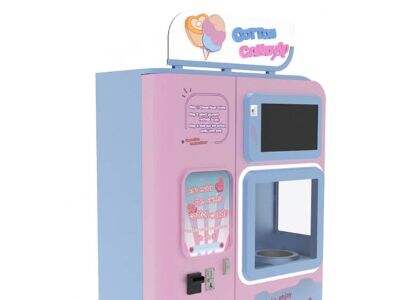Te delectat popcorn et bombicis Candy? Valde populares hi tractant pro multis, praesertim in carnivalibus et nundinis. Num miratus es quomodo haec sapida laborum fiunt? Ita miratus est et tamen tam delectatus est invenire quomodo saccharum et nuclei frumentum in yummy esculenta discursum sint ut tandem consumamus.
Faciens Cotton Candy
Candy Floss omnes in suo carmine, ut ita dicam, habet. Cum videris, videtur sicut nubes flocci et gustat verum dulce. Simile est experimentum facere parvam scientiam cum bombicis candy facis. Videri potest sicut miraculum, sed vere est processus quod sequi aliquid facere delectamentum.
Primum, saccharum in parva aqua calefacta dissolvitur. Hoc SUNZEE gooey et viscum mixtum est quod quaerimus creare bombicis candy. Tunc posuerunt eam per machinam specialem notae machinae candy bombicis, quae per candy bombicis facit. Aenean ultricies ipsum sed magna tincidunt sagittis. The Cotton Candy Machina saccharum tam celeriter deducit ut per parvas foramina et formas longas, fila tenuia bombacio similes evadat.
Machina volans saccharum fovet ut deducit, facit certum saccharum non obdurat et sistit crinitum et molle. Haec pars magni momenti est quod si saccharum nimis frigidus accipit, illas pulchras fila non formabit. Et in fine omnium, saccharo CRINITUS cepimus quod colligere possumus in conum vel baculum ad comedendum-fun. Cotton Candy fun cibus est ut consumat, similis est laetitiae in ore tuo eruptionem habens.
Quam Popcorn Pops
Nunc discutiamus aliud sapidum quaerunt: popcorn. Popcorn maxime probabile erit alumen popcorn emisti dum pelliculam vel forte nundinas spectans. Have vos umquam licet bellum de papaver popcorn? Inveniamus simul.
nuclei popcorni genus frumen- tum ex cortice specificatum. Quibus nucleis incalescentibus, intus aqua vapor. Ille vapor aedificat et nucleum intus premit. Pressio aedificat et aedificat usque ad nucleum prorumpens — intra se convertens.
Machinae ipsae popcornes fiunt ad nucleos perfecte coquendos. Lebetem habent, qui calefacit et circum nucleos aeris calidi circulens. Cum nuclei calor ad certum punctum explodunt et fiunt CRINITUS popcorn, cognovimus et amamus. Themini bombicis Candy factorem et papaver nuclei exiliunt et cadunt in unum binarium singularum infra ahenum.
Sed plus quam papaver verba ad popcorn. Factores popcorn etiam diversis saporibus et condimentis ad nucleos popcornium quos papaveri addi possunt. Omnia vetus-schola butyrum et salem licebit, vel aliquid paulo plus excitandi potes ire, ut Carmelum, caseum, condimenta vel condimenta. Sapor conformatio infinita est quae popcorn a fun tractatu facit.
Ubi sugar venit ab
Sugar essentialis est pro utroque candy bombacio et popcorn. Sic, ubi saccharum vere venire? Id magna quaestio est.
Saccharum proprie dicitur ex plantis sicut saccharum vel saccharum. Haec planta in campis crescit et cum parata colligitur. Sed metis eam plantae ad officinam eunt, ubi saccharum a plantis removetur. Hic processus saccharum a materia planta separat.
Detracto saccharo uritur. Hoc processum eliquare sordes emittit ut saccharum album, granulatum cognoscamus et amemus in demeritis et tractat. Postquam saccharum plene discursum est, syrupiam liquoris sacchari pro xylino bombico mixturam facere adhibetur, et dulcedinem popcorni addere. Hi morsus delectamenti non fere ut bonus sine saccharo.
Conversus frumentum in Popcorn
Constituto saccharo, ad alteram rem accedamus, quomodo nuclei frumenti in popcorn convertantur. nuclei popcorni sunt ex speciali genere frumenti, sed non sunt criniti commercial popcorn machina cum incipiunt. Quomodo ergo convertunt in popcorn jucundum edendum?
Primum frumentum ager maturum ac maturum metitur. Frumentum ad facilitatem expediendam deportatur, ubi nuclei a manna separantur. Hic gradus essentialis est, quia nuclei popcornes facere volumus. Cum nuclei e cob amoti sunt, sordibus et fragmentis non specificatis purgari debent. Tum secundo digestae sunt ut nuclei optimi tantum ad vendendum stipati sint.
Cum tempus est nucleos popinis, calefiunt. Calor facit ut pop, inde in illo CRINITUS, delectamento PORTIO omnes fruuntur. Metamorphosis duri nuclei ad lucem, popcorn crinitus est super fun ad spectaculum.
Candy et Popcorn: Scientia Popcorn
Cotton Candy et popcorn ut videtur simplex tractat quod amamus manducare, sed multum est scientia quae facit eas. In hanc scientiam quomodo tractantur intenderemus.
Hoc significat pro candy bombacio, tympanum lanatum intra machinam ad odorem maculam calefieri, ut saccharum liquescat. Si machina non satis celeriter nent, saccharum fila longa non formabit; si nimis celeriter volat, vel glebae frangere possunt. Questus trutina ius est crucial cum fit ad perfectum bombicum candy faciendum.
Cum popcorn, calorem iustum esse oportet ut nuclei volubilis eleganter aperiantur et non urantur. Flatus caloris tunc ab interiori nucleo, qui pressus est, cogit humorem in medium. Lebetem habet ut nucleos circummoveat ne adhaereant inter se nec urantur. Kernels quae nimis calida nimis diu urere possunt et quaerunt spolia.
In utroque casu, machinae initiales et ingredientia ad optimum exitum arcte viverra debent. Putaremus magicam esse cum has tractationes de creaturis speculamur, sed est scientia et accuratio omni modo.
Ut involvant eam, risus Candy et popcorn sunt tam ioci laborum quam multi comedunt, sed omnia genera scientiae et laboris sunt quae in creando illas yummy tractat. Ex quo saccharum ad metamorphosin nucleorum frumenti ad popcorn conficitur, hae classicae edules magnum receptaculum et interesting scientiam habent. Et, gratias Sunzee et alii similes, habere possumus hos sapidos laborum quotiens et ubicumque volumus.

 EN
EN
 AR
AR
 CS
CS
 NL
NL
 FR
FR
 DE
DE
 EL
EL
 HI
HI
 IT
IT
 JA
JA
 KO
KO
 PL
PL
 PT
PT
 RO
RO
 RU
RU
 ES
ES
 SV
SV
 TL
TL
 IW
IW
 ID
ID
 UK
UK
 VI
VI
 SQ
SQ
 HU
HU
 TH
TH
 TR
TR
 FA
FA
 AF
AF
 MS
MS
 BN
BN
 HA
HA
 LA
LA
 MY
MY
 KK
KK
 SI
SI
 TG
TG
 UZ
UZ
 KY
KY
 XH
XH

